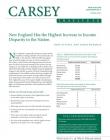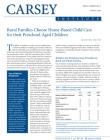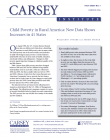Publications

April 1, 2007
Income inequality in New England is rising at the highest rate in the nation, this brief finds. Between 1989 and 2004, the region experienced the largest increase in income inequality in the country, due to both growth among top earners and the hollowing out of the middle class caused by significant changes in the nation's economy.

January 1, 2007
While members of the U.S. Senate considered the first increase in minimum wage in a decade, the Carsey Institute released findings of a study showing that it would benefit rural, low-wage workers every bit as much, if not more, than workers in big cities.

November 28, 2006
Regions of rural America are being reshaped by growing numbers of immigrants who are choosing small-town life over the bright lights of the big city. This study found that immigrant settlers may have a big impact on small, rural communities—sometimes straining resources but also offering promise for reinvigorating dying communities.

November 9, 2006
A study by the Carsey Institute found that among U.S. soldiers serving in Iraq and Afghanistan, those who are from rural America are dying at a higher rate than those soldiers who are from cities and suburbs. According to U.S. Department of Defense records, rural youth enlist in the military at a higher rate than urban and suburban youth and in all but eight states, soldiers from rural areas make...

October 3, 2006
This brief examines predatory mortgage loans and the harmful impact they have on rural homeowners and their communities. The report finds that minorities and low-income people are more likely to fall victim to higher-cost loans. The brief includes recommendations for policy changes at the state and federal levels, as well as advice on identifying and avoiding predatory loans.

October 1, 2006
The rural vote is critical, but how do rural voters' views on issues such as abortion, same-sex marriage, and religion influence elections? This brief compares rural and urban views on these divisive issues and examines how much rural opinions vary within rural regions of the country.

September 21, 2006
Vermont enjoys higher-than-average workforce participation rates and the lowest unemployment in New England, but the state's wage levels remain well below regional standards and the workforce is aging, finds this issue brief prepared by the Carsey Institute in partnership with the Public Assets Institute of Vermont. The brief highlights trends related to the economic and labor force...

July 5, 2006
This policy brief examines who is taking care of preschoolers of employed mothers in rural America. While most rural families choose home-based child care (such as relatives or informal nonrelated care providers), formal care (such as in day care centers) has positive benefits to a child's development. The brief recommends that programs are needed that either make formal care more affordable...

July 1, 2006
A study by the Carsey Institute, based on U.S. Census Bureau data, found that in forty-one states, a higher percentage of rural children live in poverty than did in 2000. While the national poverty level in 2006 was relatively stagnant compared to 2005's poverty level, the situation is clearly becoming worse for rural kids.

June 15, 2006
Alcohol abuse exceeds illicit drug abuse in rural America and is a serious problem among rural youth, as highlighted here. The report also confirms that the abuse of stimulants, including methamphetamine, is high among certain rural populations, particularly among the rural unemployed.
